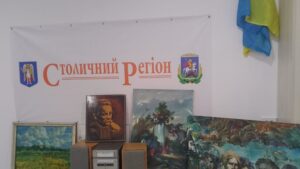
The Ukrainian Hydrometeorological Center has issued a warning about dangerous and extreme weather conditions in several regions of the country in the coming days.
On October 19, in the western, Vinnytsia, and Odesa regions, wind gusts of 15-20 m/s (level I danger, yellow) are expected during the day.
On the night of October 20 and 21, in the western regions, and on the night of October 21, in the Zhytomyr and Vinnytsia regions, there will be frosts in the air of 0-4° (level II danger, orange).
The weather conditions may complicate the work of energy, construction, and utility companies, according to the Ukrainian Hydrometeorological Center.

Japan’s Toyo Tires has announced plans to build an innovation center in the city of Injiya, Serbia. The new facility will focus on research and development in the tire industry and related technologies, a Toyo representative told local business media.
According to the project, the center will include laboratories for materials science, test benches, and research units that will collaborate with regional universities and technology startups. Construction is expected to begin in the first quarter of 2026.
Toyo Tires also plans to integrate the Serbian center into the company’s global research network, facilitating the exchange of knowledge and resources between its sites in Asia, Europe, and America. This will help accelerate the development of new compounds, innovative mixtures, and environmentally friendly solutions.
Investing in Serbia as part of this project is seen as the second stage of Toyo’s expansion in the Balkans — the company already has production facilities in Serbia and now intends to strengthen the scientific and technical core of its business.
Toyo Tires is a global tire manufacturer based in Japan. The company has been in operation since 1945 and manufactures tires for passenger cars, SUVs, trucks, and specialized equipment.
Toyo is known for its innovative solutions in the field of compounds, environmentally friendly compositions, and high testing standards. The company supplies products to more than 100 countries around the world, and its research and development network includes centers in Japan, the US, Europe, and Asia.
Toyo also actively collaborates with automotive brands and participates in motorsports, which allows it to test and develop technologies under extreme conditions.
Japan’s Toyo Tires to build innovation center in Serbia
Source: https://t.me/relocationrs/1590

The draft state budget for 2026 allocates UAH 17.9 billion for measures to support veterans, which is UAH 6.1 billion (51.5%) more than in the current year 2025, according to a statement posted on the official website of the Servant of the People party on Friday, citing Taras Tarasenko, a member of parliament from this political force and deputy chairman of the Verkhovna Rada Committee on Social Policy and Protection of Veterans’ Rights.
“Veterans are not a separate category of citizens, but part of modern Ukrainian society, which is shaped by their courage. That is why state policy is aimed at ensuring that every veteran has the opportunity to return to a full life, realize their potential, and feel dignified support from the state and the community,” Tarasenko emphasized.
He emphasized that the increase in funding applies to all key areas of veteran policy, from housing programs to psychological rehabilitation and the development of the veteran movement.
In particular, in 2026, UAH 5.7 billion is earmarked for housing compensation for veterans with disabilities of groups I and II (UAH 1.7 billion more than in the 2025 State Budget).
UAH 4 billion is earmarked for measures to support veterans, including psychological assistance, professional adaptation, the development of veteran sports, support projects, and one-time cash assistance. This is UAH 2.6 billion more than in the current year’s budget and will include new programs for converting cars to meet the needs of veterans, treating burns and scars, and adapting those who have lost their sight.
UAH 2.9 billion is earmarked for specialists to support veterans, who will help each of them navigate the process from applying to state structures to receiving all the necessary services (an increase of UAH 0.9 billion compared to the 2025 State Budget).
UAH 1.1 billion is earmarked for the creation and development of veterans’ spaces where veterans can receive counseling, psychological support, and participate in educational and community initiatives (an increase of UAH 0.6 billion compared to the 2025 State Budget).
“Support specialists, veteran spaces, and rehabilitation programs are an investment in human capital, in returning soldiers to a life where they feel support, respect, and the opportunity to move forward. We are trying to build a system centered on people who have gone through war,” said the MP.
He also emphasized the importance of communication with municipal and public institutions and veterans’ organizations, since the network of veterans’ spaces cannot be based solely on state institutions, but must bring together all existing initiatives.
“Only together can we create an effective system. Because when a veteran is forced to run between different spaces in search of help, it is not useful for him or for the system as a whole. Our goal is to ensure that veteran policy is not reduced to privileges, but becomes a system of opportunities,” Tarasenko concluded.

Demand for charging stations, generators, and power banks increased by an average of 3.5 times, while prices for these categories of goods rose by 10-20%, returning to market levels, according to omnichannel retailer Foxtrot.
“In just four days (October 10-13), sales of charging stations, power banks, and generators were comparable to the figures for the previous three months combined. Portable charging stations showed the highest growth: +400% compared to the previous day last Friday alone,” said Vyacheslav Sklonny, commercial director of Foxtrot, in response to a request from Interfax-Ukraine.
Demand began to grow in the last week of August and peaked after a massive enemy attack on critical infrastructure on October 10. According to the chain, sales of charging stations and related product categories in September exceeded August figures by 70%.
Sales of charging stations grew 3.6 times in monetary terms and four times in volume; power banks grew six times (in monetary terms and in units); and router cables grew 3.5 times and four times, respectively.
In addition, after a period of significant discounts amid weak demand in the summer, when the energy supply situation was more stable, prices returned to market levels, with an increase of 10-20%.
“This is not an artificial jump in prices, but a return to the real market level, because previously stations were sold below cost due to a lack of demand for this product. In addition, demand has grown significantly, and stocks in Ukraine and Europe are rapidly declining,” explained Sklonny.
Foxtrot is one of Ukraine’s largest omnichannel retail chains in terms of the number of stores and sales of electronics and household appliances. As of early October 2025, the company operates 127 stores in 68 cities, the online platform Foxtrot.ua, and the mobile app of the same name.
According to Opendatabot, the revenue of FTD-Retail LLC (Kyiv), which develops the chain, amounted to UAH 14 billion 882.632 million in 2024, which is 17.6% more than in 2023, and its net profit was UAH 6 million 721 thousand against UAH 314 million 436 thousand, respectively.
In the first half of 2025, the company received UAH 7.3 billion in revenue and UAH 66.5 million in net losses.
The founders of the omnichannel retailer Foxtrot are Ukrainian businessmen Gennady Vykhodtsev and Valery Makovetsky.

The Capital Region regional press center has been officially opened in the Kyiv region, designed to become a new media and analytical hub for interaction between the media, the public, the authorities, and business.
The opening was organized by the My Kyiv Region news agency and the editorial office of the Slovo i Dilo newspaper. The event featured the presentation of work plans and an exhibition of works by Ukrainian artists from different regions of the Kyiv region.
The Capital Region press center aims to bring together journalists, social activists, entrepreneurs, cultural figures, and government officials to discuss and promote issues of recovery, reform, and regional development.
Key formats include round tables, discussions, interviews, press conferences, as well as sociological research and charity events. Significant attention will be paid to journalistic investigations and the study of foreign experience in the development of metropolitan areas.
At the opening, it was noted that on October 10, a press conference was held at the Interfax-Ukraine press center on the topic “The end of local government powers: what next and what are the risks for communities,” which underscores the Capital Region’s desire to become a point of intersection between the media environment and regional discussion.
The creation of such a press center in the Kyiv region is important not only as a local project, but also as a platform for consolidating information, strengthening ties between the public and the authorities, exchanging opinions, and formulating development strategies.
The activities of the Capital Region can strengthen the role of local media, improve the quality of analytics and communications in the region, and serve as a link between the capital and the region.

Against the backdrop of rapid growth in international gold prices, residents of a number of Asian countries really did rush to buy bullion — and in the first half of the day, stores sometimes closed by noon. Vietnamese people in a number of cities lined up at dawn when legislation finally abolished the state monopoly on gold trading.
Meanwhile, the price of gold has already surpassed $4,300 per ounce and continues to hit historic highs.
Growing expectations of a Fed interest rate cut and tensions in US-China relations have pushed investors toward “safe havens” — gold has become a safe asset. Against the backdrop of inflationary pressure and market volatility, the precious metal is once again in the spotlight for investors.
In Australia, at the peak of gold price growth, areas and rivers traditionally used by amateur gold miners (washing gold in river streams) are once again attracting attention. Some people are earning hundreds of dollars in just a few hours. This phenomenon is being covered by the media as a “gold renaissance” not only in the corporate sector, but also among mass investors.
Earlier, the Experts Club analytical center presented an analysis of the world’s leading gold-producing countries in its video on YouTube channel — https://youtube.com/shorts/DWbzJ1e2tJc?si=YuRnDiu7jtfUPBR9